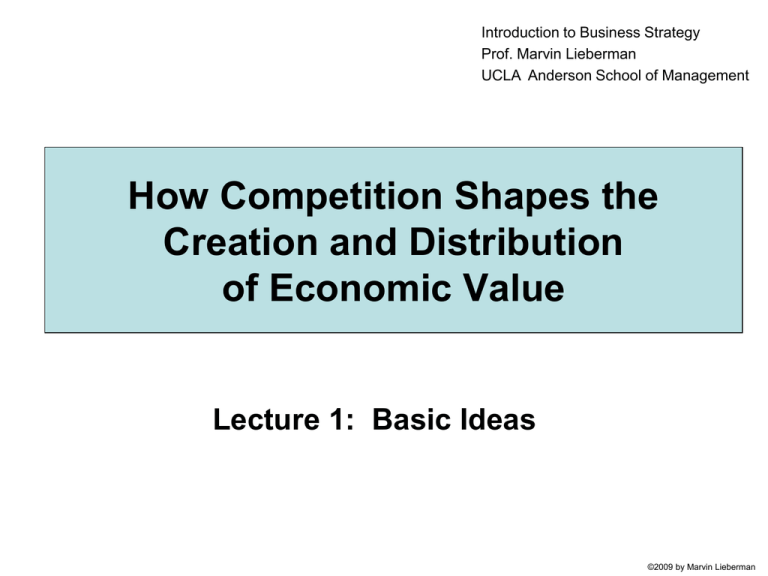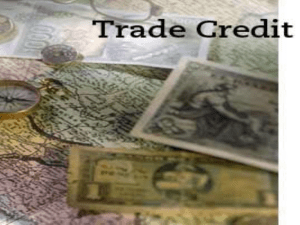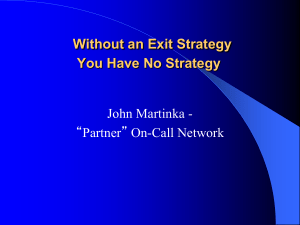Basic Ideas - UCLA Anderson School of Management
advertisement

Introduction to Business Strategy Prof. Marvin Lieberman UCLA Anderson School of Management How Competition Shapes the Creation and Distribution of Economic Value Lecture 1: Basic Ideas ©2009 by Marvin Lieberman Creating and Capturing Economic Value - The Essence of Business Strategy Business strategy is ultimately about the creation and capture of economic value. The term, “value proposition”, is often used to describe the specific way that a firm creates economic value and shares some of that value with its customers. The value created by the firm may also be divided among a broader set of stakeholders, including resource providers and suppliers. Any firm that fails to create, capture and share economic value will fail to survive. ©2009 by Marvin Lieberman These Lectures These interactive lectures are designed to introduce key ideas in business strategy relating to the creation and capture of economic value. Through a series of examples, the lectures are intended to make your understanding more precise. We will consider how, in an environment with differences or “heterogeneity” among buyers and sellers, the competitive process largely determines the distribution of value. The ideas draw upon and extend basic concepts that are commonly taught in introductory economics courses. We will link these economic concepts to two popular frameworks in business strategy: “Porter’s five forces” and “competitive advantage”. The examples in these lectures are representative of real business situations. Nevertheless, the examples have been stripped down to their most essential elements in order to focus on the key ideas. The examples may therefore seem very abstract. To help you make connections between the “theoretical” examples and actual business situations, the lectures will occasionally suggest some real-life cases, but mostly that exercise is left for you. ©2009 by Marvin Lieberman Value Creation and Capture What, exactly, does it mean to say that a firm creates and captures value? The idea that a successful firm creates economic value seems intuitive. And it is not surprising that if a firm is unable to capture any of the value that it creates, the firm will fail to survive. For example, a firm that introduces a useful technological innovation creates value (for society). Even so, if the firm cannot protect its innovation from competition, it will be driven out of business by rivals that can copy the innovation and potentially improve upon it. Such logic is understood and applied by businesspeople every day, and you do not need a formal course to reach this basic level of insight. To gain deeper understanding, though, you must learn to assess value creation and capture in a more precise way. These lectures are intended as an initial step to develop your skills to make quantitative assessments in specific business contexts. ©2009 by Marvin Lieberman To begin, let’s consider some simple examples… We begin with a very common situation: a single buyer facing a single seller. ©2009 by Marvin Lieberman Example 1.1 Consider a market with one firm which can produce one unit of “product” at cost=0. F ©2009 by Marvin Lieberman Example 1.1 Consider a market with one firm which can produce one unit of “product” at cost=0. F B And one buyer, able to consume one unit of product, for which the buyer is “willing to pay” up to $1 (i.e., the value to the buyer of consuming the product is $1). ©2009 by Marvin Lieberman Example 1.1 Consider a market with one firm which can produce one unit of “product” at cost=0. F B And one buyer, able to consume one unit of product, for which the buyer is “willing to pay” up to $1 (i.e., the value to the buyer of consuming the product is $1). This notion of “willingness to pay” (WTP) will be central in our analysis. Note that the “willingness to pay” is not the price. It represents the maximum price that the buyer would pay for the product. If the product is obtained at a price below the WTP, the buyer is getting a “good deal” and enjoys an increment of value equal to the difference between WTP and the price that is actually paid. (Economists refer to this increment as “consumer surplus”.) ©2009 by Marvin Lieberman Example 1.1 Very simply, we have: One firm able to produce one unit of “product” at cost=0. F B One buyer, able to consume one unit of “product,” and willing to pay up to $1. ©2009 by Marvin Lieberman Example 1.1 One firm able to produce one unit of “product” at cost=0. F B One buyer, able to consume one unit of “product,” and willing to pay up to $1. The situation here is one that often arises in business. You might think of the firm as the creator or seller of a specialized asset, facing a unique buyer for that asset. ©2009 by Marvin Lieberman Example 1.1 One firm able to produce one unit of “product” at cost=0. F B One buyer, able to consume one unit of “product,” and willing to pay up to $1. The situation here is one that often arises in business. You might think of the firm as the creator or seller of a specialized asset, facing a unique buyer for that asset. You should not take the buyer’s willingness to pay (WTP) of $1 literally; it serves to represent the buyer’s upper limit. Larger values may be substituted here and in subsequent examples with no loss of generality. Similarly, the assumption of zero production cost is made to simplify the situation. ©2009 by Marvin Lieberman Example 1.1 One firm able to produce one unit of “product” at cost=0. F B One buyer, able to consume one unit of “product,” and willing to pay up to $1. Now, let’s consider value creation and capture in this context. Can you answer the following questions? ©2009 by Marvin Lieberman Example 1.1 One firm able to produce one unit of “product” at cost=0. F B One buyer, able to consume one unit of “product,” and willing to pay up to $1. • What will be the price (P) of the “product”? 0<P≤1 • How much value (V) is created? V=1 • Who captures that value? “pure bargaining” case Linking to your economics class, “V” is the “total surplus” ( = consumer surplus + producer surplus ). ©2009 by Marvin Lieberman Example 1.1 One firm able to produce one unit of “product” at cost=0. F B One buyer, able to consume one unit of “product,” and willing to pay up to $1. In this first example, the distribution of value is defined solely by bargaining between the buyer and seller. The $1 of created value could go mostly to the buyer, or to the seller, depending on where the price is set. ©2009 by Marvin Lieberman Example 1.1 One firm able to produce one unit of “product” at cost=0. F $1 B T O T A L V A L U E 0 = Firm’s cost } Value captured by Firm P = Price } Value captured by Buyer $1 = Buyer’s WTP One buyer, able to consume one unit of “product,” and willing to pay up to $1. In this first example, the distribution of value is defined solely by bargaining between the buyer and seller. The $1 of created value could go mostly to the buyer, or to the seller, depending on where the price is set. ©2009 by Marvin Lieberman Example 1.1 One firm able to produce one unit of “product” at cost=0. F 0 = Firm’s cost P If bargaining leads to a Price near 0, the Buyer captures most of the value. B $1 = Buyer’s WTP One buyer, able to consume one unit of “product,” and willing to pay up to $1. If the buyer is a good bargainer, she may be able to get the seller to agree to a price close to zero. In addition to bargaining skill, an important determinant of the ultimate price may be the information available to the buyer and seller. If the buyer knows that the seller’s cost is zero, but the seller is unaware of the buyer’s full willingness to pay, an outcome with price close to zero could easily arise. ©2009 by Marvin Lieberman Example 1.1 One firm able to produce one unit of “product” at cost=0. 0 = Firm’s cost F B If bargaining leads to a Price near $1, the Firm (seller) captures most of the value. P $1 = Buyer’s WTP One buyer, able to consume one unit of “product,” and willing to pay up to $1. The converse also applies; if the seller knows that the buyer is willing to pay up to $1, but the buyer does not know the seller’s true cost, the price is likely to end up near $1. ©2009 by Marvin Lieberman Example 1.1 One firm able to produce one unit of “product” at cost=0. 0 = Firm’s cost F P = $.50 B $1 = Buyer’s WTP One buyer, able to consume one unit of “product,” and willing to pay up to $1. Alternatively, if the cost and WTP are known to both parties, they might agree that $.50 is a “fair” price that allows them to share the surplus equally. ©2009 by Marvin Lieberman Example 1.1 One firm able to produce one unit of “product” at cost=0. F B One buyer, able to consume one unit of “product,” and willing to pay up to $1. If this bargaining example seems too abstract, it may be helpful to consider an explicit situation. Assume that you are at a street fair. While you are standing near his booth, an artist has drawn a sketch of you (or a family member) in the hope that you may be willing to buy it. The artist’s cost is effectively zero at this point. You like the sketch and would be willing to pay up to $1 for it. In this situation, you and the artist should be able to reach an agreement on price in the range between zero and $1. If you do so, the $1 of value created will be split between you. (In this specific example, you know that the artist’s cost is zero, but the artist doesn’t know your true WTP. Therefore, if you are a hard bargainer, you may be able to drive the price very low. Even so, notions of “fairness” may prevent one side or the other from settling at “too low” a price.) ©2009 by Marvin Lieberman Example 1.1 One firm able to produce one unit of “product” at cost=0. F B One buyer, able to consume one unit of “product,” and willing to pay up to $1. The remaining examples in this lecture show what happens when we add competition to this basic set up. In all examples, we will assume that all participants actually compete; i.e., there is no collusion among buyers or sellers. We’ll start by adding competition on the buyer side. ©2009 by Marvin Lieberman Example 1.2 One firm able to produce one unit of “product” at cost=0. F B1 Let’s add a second buyer, also able to consume one unit of product, and willing to pay up to $1. Introduction of the second buyer gives the firm power to play the two buyers off against each other, thereby pushing the price to the upper limit. • What will be the price of the “product”? P=1 • How much value is created? V=1 • Who captures that value? “simple monopoly” case (F captures all value) Personal Example Example 1.2 has one seller facing two competing buyers. However, a single buyer can play off two (non-colluding) sellers in the same way. Many years ago in India I learned how this type of “Bertrand competition” can easily play out. I was in a remote area and needed to get back to town. A rickshaw driver appeared and offered to take me there for 10 rupees. I was willing to pay that price, if necessary. However, I knew that 10 rupees was well above the price charged to locals, so I attempted to bargain, but he was immovable. (Note that I was in a position like the buyer in Example 1.1.) A few minutes later a second rickshaw driver appeared. He quoted the identical 10 rupees. I then turned to the first driver and asked if he would accept a price of 9 rupees. He said yes. I asked the second driver if he would take 8. He too said yes. This process continued until the second driver and I settled on a price of just one rupee. My bargaining position had improved dramatically! After arriving back in town, I paid the driver the single rupee. Then, out of a notion of fairness – and recognition that the second driver’s arrival had enabled me to capture the entire surplus in this transaction – I shared some of that surplus with him in the form of a tip. ©2009 by Marvin Lieberman Now, let’s add some heterogeneity among the buyers and sellers, starting with the buyers’ side. ©2009 by Marvin Lieberman Example 1.3 One firm able to produce one unit of “product” at cost=0. F B1 B2 wtp=1 wtp=.6 Now, let’s assume that the second buyer is willing to pay at most $0.6. (i.e., the value to buyer 2 of consuming the product is $0.6.) In this case, by playing off the buyers, the firm can raise the price only to $0.6. The firm may be able to negotiate a price above this level through bargaining with B1. But if B1 knows that B2’s reservation price is only $0.6, it may be able to avoid paying a higher price. • What will be the price of the “product”? 0.6 < P ≤ 1 • How much value is created? V=1 • Who captures that value? Split between F and B1. Competition and Bargaining Ranges • In Example 1.3, above, competition was sufficient to drive price to the upper limit of a range (specifically, from 0 to 0.6). The remaining gap between cost and WTP was a zone where price was set by bargaining. In the real world this is often the case: competition typically serves as the main determinant of prices, but there may be a zone where bargaining can occur. • In most of the examples that follow, the bargaining zone has been eliminated to simplify the analysis and emphasize the role of competition. (This is achieved in in many of the examples by removing capacity constraints. When firms can produce without limit, they tend to engage in very sharp, “Bertrand” type competition.) ©2009 by Marvin Lieberman Further Assumptions • We make other assumptions to ensure that competition reaches its full potential effect. As mentioned above, we rule out collusion among buyers or sellers (explicit or implicit). We assume that buyers and sellers attempt to achieve their most favorable outcome, without regard for the welfare of others. (This rules out any notions of “fairness.”) Moreover, all transactions are assumed to take place only once, so there is no potential for reciprocity, which could support collusion or other softening of price competition. • We also assume that all parties are fully informed regarding firms’ costs and buyers’ willingness to pay. This is obviously a very strong assumption, unlikely to be satisfied in practice, but it serves to reduce or eliminate the range for bargaining and potential “bluffing.” In addition, we rule out all uncertainty, except for a few specific cases. • A final assumption is that firms cannot price discriminate (i.e., sell identical units to different buyers at different prices). All units are sold at the same price. ©2009 by Marvin Lieberman Relaxing the Assumptions In practice, these assumptions – full information, no collusion, no price discrimination, no capacity constraints, and no uncertainty – are unlikely to hold in their entirety. That is why price competition is seldom as sharp as in these examples, and outcomes are unlikely to be so precisely defined. Even so, the examples in these lectures may be viewed as benchmark cases that illustrate the role of competition in determining the distribution of economic value. Let’s continue to develop the examples by adding additional buyers and sellers. We start by adding additional buyers to Example 1.3. ©2009 by Marvin Lieberman Example 1.4 Assume again that the firm can produce only one unit at cost=0. F B1 B2 B3 B4 B5 wtp=1.0 wtp=0.8 wtp=0.6 wtp=0.4 wtp=0.2 Now we have five potential buyers who can each consume one unit, but they differ in their valuation of the product. • What will be the price of the “product”? 0.8 < P ≤ 1 (i.e., a small bargaining range) • How much value is created? V=1 • Who captures that value? Split between F and B1 ©2009 by Marvin Lieberman Example 1.5 Now assume that the firm can produce at cost=0 with no output constraint. (All units must be sold at the same price.) F B1 B2 B3 B4 B5 wtp=1.0 wtp=0.8 wtp=0.6 wtp=0.4 wtp=0.2 Units Price TR MR 1 1.0 1.0 1.0 2 0.8 1.6 0.6 3 0.6 1.8 0.2 4 0.4 1.6 -0.2 5 0.2 1.0 -0.6 This is similar to the case of a monopolist facing a downward sloping demand curve, as discussed in any economics textbook. With cost equal to zero, the monopolist sets price to maximize its total revenue (TR). • What will be the price of the “product”? P = 0.6 • How much value is created? V = 2.4 • Who captures that value? F gets 1.8 B1 gets 0.4 B2 gets 0.2 B3 gets zero (= 1.0 + 0.8 + 0.6) Example 1.6 Now assume that that a second firm enters. This firm also has production cost=0 and no output constraint. F1 F2 B1 B2 B3 B4 B5 wtp=1.0 wtp=0.8 wtp=0.6 wtp=0.4 wtp=0.2 Here, each buyer can play off the two firms to push the price down to virtually zero. Note that “total surplus” is maximized in this case, but profits are eliminated. • What will be the price of the “product”? P=0 • How much value is created? V = 3.0 • Who captures that value? F1 and F2 get zero B1 gets 1.0 B2 gets 0.8 etc. (or .01) “Bertrand” competition (= 1 + .8 + .6 + .4 + .2) Example 1.7 Now assume that that F1 can produce at cost 0, but F2 has unit cost=0.4. Neither firm has an output constraint. F1 F2 c=0 c=.4 B1 B2 B3 B4 B5 wtp=1.0 wtp=0.8 wtp=0.6 wtp=0.4 wtp=0.2 In this case, F1 has a cost advantage over F2 and is able to capture the value associated with that advantage as profit. We will explore cost advantage in greater detail in another lecture. • What will be the price of the “product”? P = 0.4(-ε) Competition drives price just below 0.4. • How much value is created? V = 2.8 • Who captures that value? F1 gets 1.6; F2 gets zero B1 gets 0.6 B2 gets 0.4 B3 gets 0.2 (= 1 + .8 + .6 + .4) Conclusions from Lecture 1 • We have now introduced the main ideas, which will be developed further in the subsequent lectures. • Let’s summarize the key points so far. ©2009 by Marvin Lieberman Key “Take Aways” • Value creation arises from the difference between: (1) consumers’ “willingness to pay” (WTP), and (2) producers’ cost. (Recall the concept of consumer and producer surplus from economics.) • The distribution of this value between buyer and seller depends on competition and bargaining. Competition defines the range in which bargaining can occur. ©2009 by Marvin Lieberman Themes to be Further Developed • Other things equal, an increase in buyer WTP or a reduction in producer cost lead to a gain in economic value. • Business strategies create value in one (or both) of these ways. • Business strategies also allow the firm to capture value. • The firm’s ability to capture value depends on competition. Thus, managers need to understand the competitive forces and potentially act to shape these forces in favor of their firm. ©2009 by Marvin Lieberman Appendix: Cooperative Game Theory and Value-Based Strategy A literature has emerged in recent years on the value-based foundations of business strategy. This literature draws from concepts of cooperative game theory and may be of interest to those who wish to deepen their understanding of ideas introduced in these lectures. Representative articles include the following: 1. Brandenburger, A. M., & Stuart, H. W. 1996. Value-based business strategy. Journal of Economics and Management Strategy, 5(1): 5-24. 2. Brandenburger, A. M., & Stuart, H. W. 2007. Biform Games. Management Science, 53(April): 537-549. 3. Chatain, O., & Zemsky, P. 2009. Value-Based Strategy with Frictions. Insead Business School working paper. 4. Lippman, S. A., & Rumelt, R. P. 2003. A bargaining perspective on resource advantage. Strategic Management Journal, 24(11): 1069-1086. 5. MacDonald, G., & Ryall, M. D. 2004. How Do Value Creation and Competition Determine Whether a Firm Appropriates Value? Management Science, 50(10): 1319.








